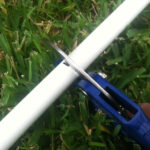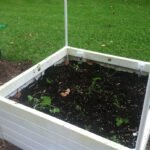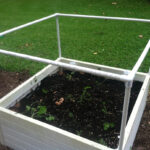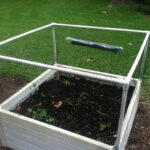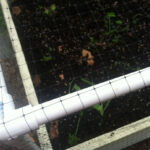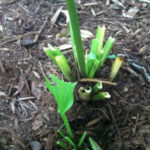
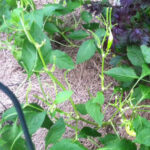
Three young fawns and a doe have discovered my garden just recently. They ate all of the leaves off of the pepper plants, devoured the hostas, stripped the bean plants bare, and ate every single beet top.
Now that they’ve found us, I’m sure they will continue to come back. I am starting to think about planting for a fall crop of vegetables, so I have to be creative in planting.
Making a Deer Exclosure for Raised Beds
The Terrazza Raised Beds, which I reviewed in an earlier post, have caps on the four posts that make up the corners. Luckily, the posts are hollow. I decided to use these as the supports for my deer exclosure.
Materials
- 270” of ½” PVC pipe
- PVC glue
- Bird netting
- 4 each of ½” 90 degree side outlet elbows (PVC)
- PVC pipe cutters
- Wire or zip ties to attach the netting to the pipe
- Measuring tape
I made the vertical PVC posts 30” tall and the horizontal posts are 37.5” tall. I used the PVC pipe cutters to make my cuts – while they aren’t absolutely necessary for the project, they sure make cutting so much easier.
I glued the horizontal pipes to the elbows, but left the vertical pipes unglued. I also left horizontal one side unglued in case I needed to get access to the bed that way. Make sure your elbows aren’t threaded.
I laid the netting overtop the frame and attached it using zip ties, making sure the netting was pulled tightly. I anticipate lifting the entire frame up in order to reach the vegetables.
Double-Use for the Frame: Greenhouse
In the winter, I will convert this frame to a small greenhouse, using plastic instead of netting to create a box. I plan on cutting the plastic so that I can vent the top easily when needed.
Overall Cost
I purchased all of my PVC pipe and elbow supplies from Lowe’s (and the glue) and it ran me about $20. I already had everything else in stock.
Time to Make
Once I got everything in one location, it took about 25 minutes to cut everything, glue it, attach the netting, and plant the seeds.
Other Raised Beds
You could make a similar exclosure for other types of raised beds – you’ll just need to adjust the thickness of the PVC pipe and the number of vertical and horizontal supports to fit your garden’s size and shape. Additionally, you’ll need to provide something for the PVC pipe to attach to on the ground (to keep it from slipping or coming out of the soil) or use horizontal supports and elbows at the bottom to create a full box. A bit of rebar driven in to the ground would work. If you fit the PVC frame on the inside of your raised bed, that might be enough support.


